2007 ISUZU KB P190 ECO mode
[x] Cancel search: ECO modePage 5693 of 6020
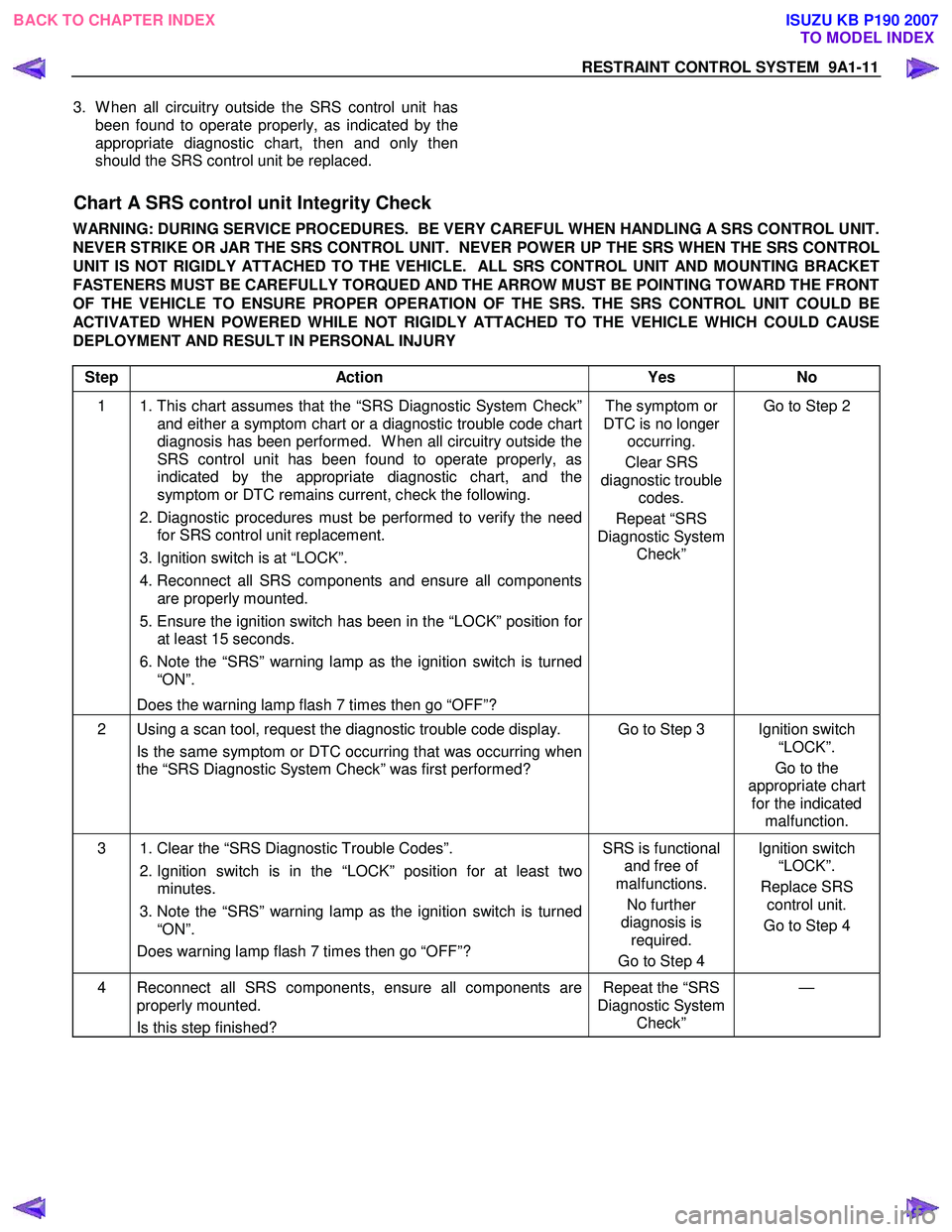
RESTRAINT CONTROL SYSTEM 9A1-11
3. W hen all circuitry outside the SRS control unit has been found to operate properly, as indicated by the
appropriate diagnostic chart, then and only then
should the SRS control unit be replaced.
Chart A SRS control unit Integrity Check
WARNING: DURING SERVICE PROCEDURES. BE VERY CAREFUL WHEN HANDLING A SRS CONTROL UNIT.
NEVER STRIKE OR JAR THE SRS CONTROL UNIT. NEVER POWER UP THE SRS WHEN THE SRS CONTROL
UNIT IS NOT RIGIDLY ATTACHED TO THE VEHICLE. ALL SRS CONTROL UNIT AND MOUNTING BRACKET
FASTENERS MUST BE CAREFULLY TORQUED AND THE ARROW MUST BE POINTING TOWARD THE FRONT
OF THE VEHICLE TO ENSURE PROPER OPERATION OF THE SRS. THE SRS CONTROL UNIT COULD BE
ACTIVATED WHEN POWERED WHILE NOT RIGIDLY ATTACHED TO THE VEHICLE WHICH COULD CAUSE
DEPLOYMENT AND RESULT IN PERSONAL INJURY
Step Action Yes No
1 1. This chart assumes that the “SRS Diagnostic System Check”
and either a symptom chart or a diagnostic trouble code chart
diagnosis has been performed. W hen all circuitry outside the
SRS control unit has been found to operate properly, as
indicated by the appropriate diagnostic chart, and the
symptom or DTC remains current, check the following.
2. Diagnostic procedures must be performed to verify the need
for SRS control unit replacement.
3. Ignition switch is at “LOCK”.
4. Reconnect all SRS components and ensure all components are properly mounted.
5. Ensure the ignition switch has been in the “LOCK” position for
at least 15 seconds.
6. Note the “SRS” warning lamp as the ignition switch is turned
“ON”.
Does the warning lamp flash 7 times then go “OFF”? The symptom or
DTC is no longer occurring.
Clear SRS
diagnostic trouble codes.
Repeat “SRS
Diagnostic System Check” Go to Step 2
2 Using a scan tool, request the diagnostic trouble code display.
Is the same symptom or DTC occurring that was occurring when
the “SRS Diagnostic System Check” was first performed? Go to Step 3 Ignition switch
“LOCK”.
Go to the
appropriate chart for the indicated malfunction.
3 1. Clear the “SRS Diagnostic Trouble Codes”.
2. Ignition switch is in the “LOCK” position for at least two
minutes.
3. Note the “SRS” warning lamp as the ignition switch is turned
“ON”.
Does warning lamp flash 7 times then go “OFF”? SRS is functional
and free of
malfunctions.
No further
diagnosis is required.
Go to Step 4 Ignition switch
“LOCK”.
Replace SRS control unit.
Go to Step 4
4 Reconnect all SRS components, ensure all components are properly mounted.
Is this step finished? Repeat the “SRS
Diagnostic System Check” —
BACK TO CHAPTER INDEX
TO MODEL INDEX
ISUZU KB P190 2007
Page 5695 of 6020
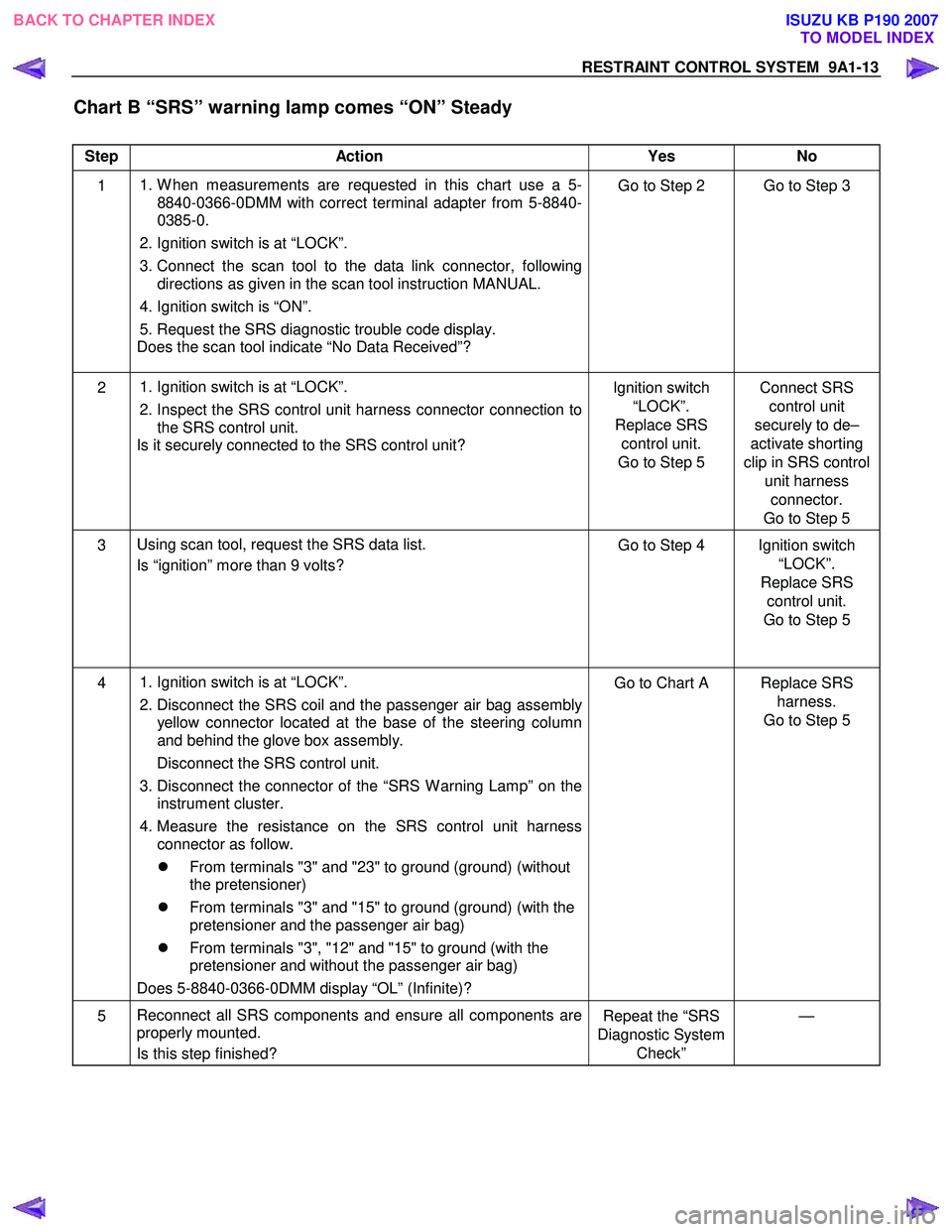
RESTRAINT CONTROL SYSTEM 9A1-13
Chart B “SRS” warning lamp comes “ON” Steady
Step Action Yes No
1
1. W hen measurements are requested in this chart use a 5-
8840-0366-0DMM with correct terminal adapter from 5-8840-
0385-0.
2. Ignition switch is at “LOCK”.
3. Connect the scan tool to the data link connector, following
directions as given in the scan tool instruction MANUAL.
4. Ignition switch is “ON”.
5. Request the SRS diagnostic trouble code display.
Does the scan tool indicate “No Data Received”? Go to Step 2 Go to Step 3
2
1. Ignition switch is at “LOCK”.
2. Inspect the SRS control unit harness connector connection to
the SRS control unit.
Is it securely connected to the SRS control unit? Ignition switch
“LOCK”.
Replace SRS control unit.
Go to Step 5 Connect SRS
control unit
securely to de–
activate shorting
clip in SRS control unit harness connector.
Go to Step 5
3 Using scan tool, request the SRS data list.
Is “ignition” more than 9 volts? Go to Step 4 Ignition switch
“LOCK”.
Replace SRS control unit.
Go to Step 5
4
1. Ignition switch is at “LOCK”.
2. Disconnect the SRS coil and the passenger air bag assembly
yellow connector located at the base of the steering column
and behind the glove box assembly.
Disconnect the SRS control unit.
3. Disconnect the connector of the “SRS W arning Lamp” on the
instrument cluster.
4. Measure the resistance on the SRS control unit harness connector as follow.
�z From terminals "3" and "23" to ground (ground) (without
the pretensioner)
�z From terminals "3" and "15" to ground (ground) (with the
pretensioner and the passenger air bag)
�z From terminals "3", "12" and "15" to ground (with the
pretensioner and without the passenger air bag)
Does 5-8840-0366-0DMM display “OL” (Infinite)? Go to Chart A Replace SRS
harness.
Go to Step 5
5 Reconnect all SRS components and ensure all components are
properly mounted.
Is this step finished? Repeat the “SRS
Diagnostic System Check” —
BACK TO CHAPTER INDEX
TO MODEL INDEX
ISUZU KB P190 2007
Page 5697 of 6020
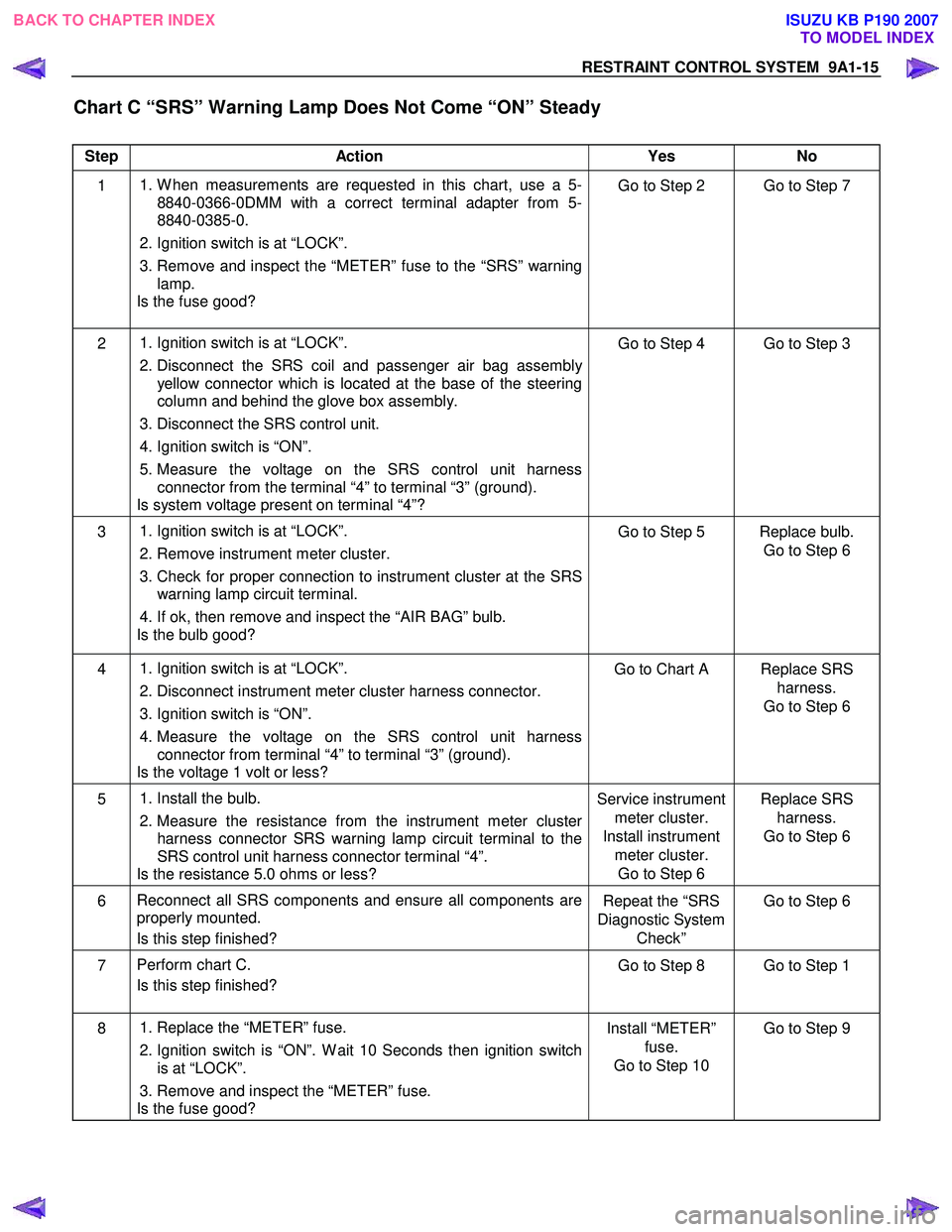
RESTRAINT CONTROL SYSTEM 9A1-15
Chart C “SRS” Warning Lamp Does Not Come “ON” Steady
Step Action Yes No
1
1. W hen measurements are requested in this chart, use a 5-
8840-0366-0DMM with a correct terminal adapter from 5-
8840-0385-0.
2. Ignition switch is at “LOCK”.
3. Remove and inspect the “METER” fuse to the “SRS” warning lamp.
Is the fuse good? Go to Step 2 Go to Step 7
2
1. Ignition switch is at “LOCK”.
2. Disconnect the SRS coil and passenger air bag assembly
yellow connector which is located at the base of the steering
column and behind the glove box assembly.
3. Disconnect the SRS control unit.
4. Ignition switch is “ON”.
5. Measure the voltage on the SRS control unit harness connector from the terminal “4” to terminal “3” (ground).
Is system voltage present on terminal “4”? Go to Step 4 Go to Step 3
3
1. Ignition switch is at “LOCK”.
2. Remove instrument meter cluster.
3. Check for proper connection to instrument cluster at the SRS warning lamp circuit terminal.
4. If ok, then remove and inspect the “AIR BAG” bulb.
Is the bulb good? Go to Step 5 Replace bulb.
Go to Step 6
4
1. Ignition switch is at “LOCK”.
2. Disconnect instrument meter cluster harness connector.
3. Ignition switch is “ON”.
4. Measure the voltage on the SRS control unit harness
connector from terminal “4” to terminal “3” (ground).
Is the voltage 1 volt or less? Go to Chart A Replace SRS
harness.
Go to Step 6
5
1. Install the bulb.
2. Measure the resistance from the instrument meter cluster
harness connector SRS warning lamp circuit terminal to the
SRS control unit harness connector terminal “4”.
Is the resistance 5.0 ohms or less? Service instrument
meter cluster.
Install instrument meter cluster. Go to Step 6 Replace SRS
harness.
Go to Step 6
6 Reconnect all SRS components and ensure all components are
properly mounted.
Is this step finished? Repeat the “SRS
Diagnostic System Check” Go to Step 6
7
Perform chart C.
Is this step finished? Go to Step 8 Go to Step 1
8
1. Replace the “METER” fuse.
2. Ignition switch is “ON”. W ait 10 Seconds then ignition switch
is at “LOCK”.
3. Remove and inspect the “METER” fuse.
Is the fuse good? Install “METER”
fuse.
Go to Step 10 Go to Step 9
BACK TO CHAPTER INDEX
TO MODEL INDEX
ISUZU KB P190 2007
Page 5698 of 6020
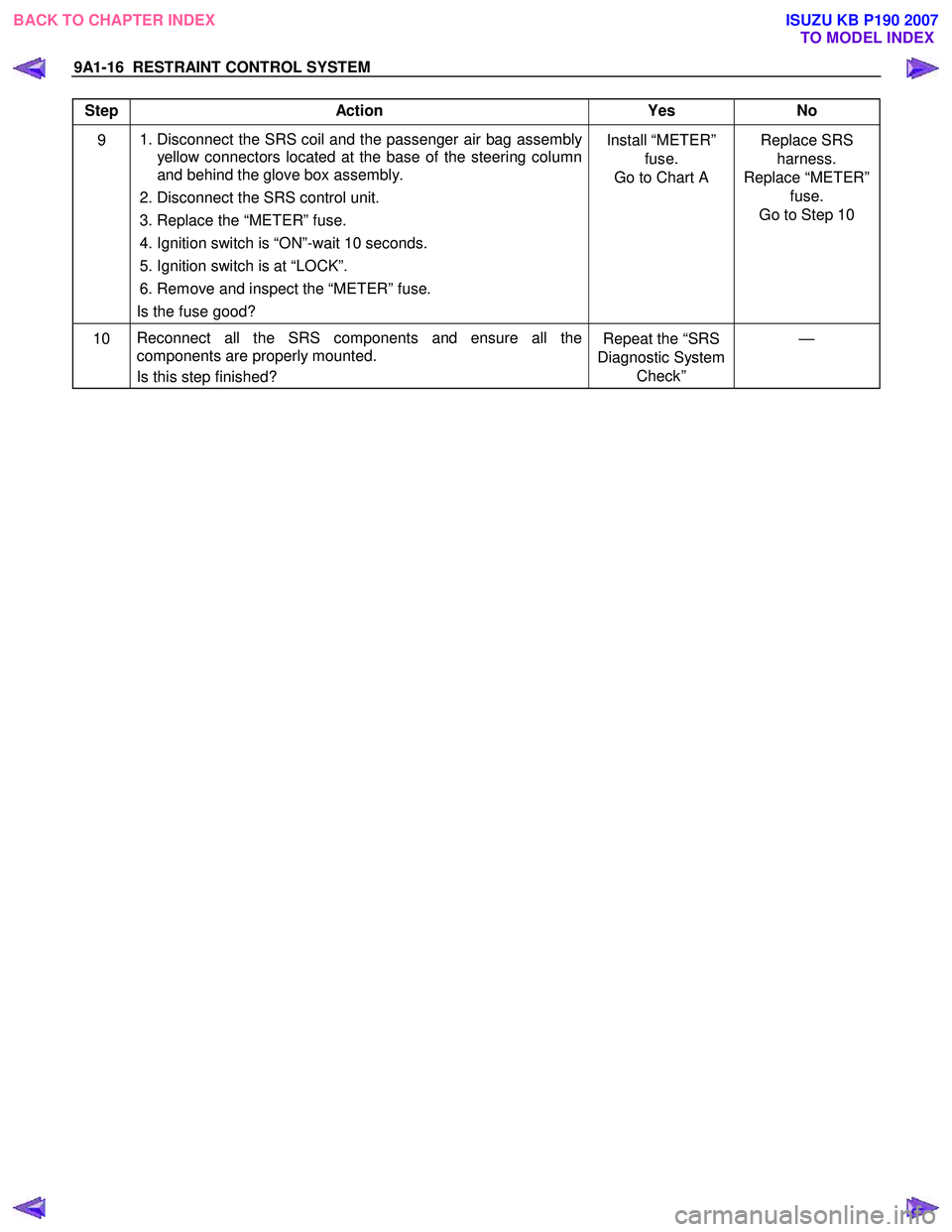
9A1-16 RESTRAINT CONTROL SYSTEM
Step Action Yes No
9
1. Disconnect the SRS coil and the passenger air bag assembly
yellow connectors located at the base of the steering column
and behind the glove box assembly.
2. Disconnect the SRS control unit.
3. Replace the “METER” fuse.
4. Ignition switch is “ON”-wait 10 seconds.
5. Ignition switch is at “LOCK”.
6. Remove and inspect the “METER” fuse.
Is the fuse good? Install “METER”
fuse.
Go to Chart A Replace SRS
harness.
Replace “METER” fuse.
Go to Step 10
10 Reconnect all the SRS components and ensure all the
components are properly mounted.
Is this step finished? Repeat the “SRS
Diagnostic System Check” —
BACK TO CHAPTER INDEX
TO MODEL INDEX
ISUZU KB P190 2007
Page 5700 of 6020
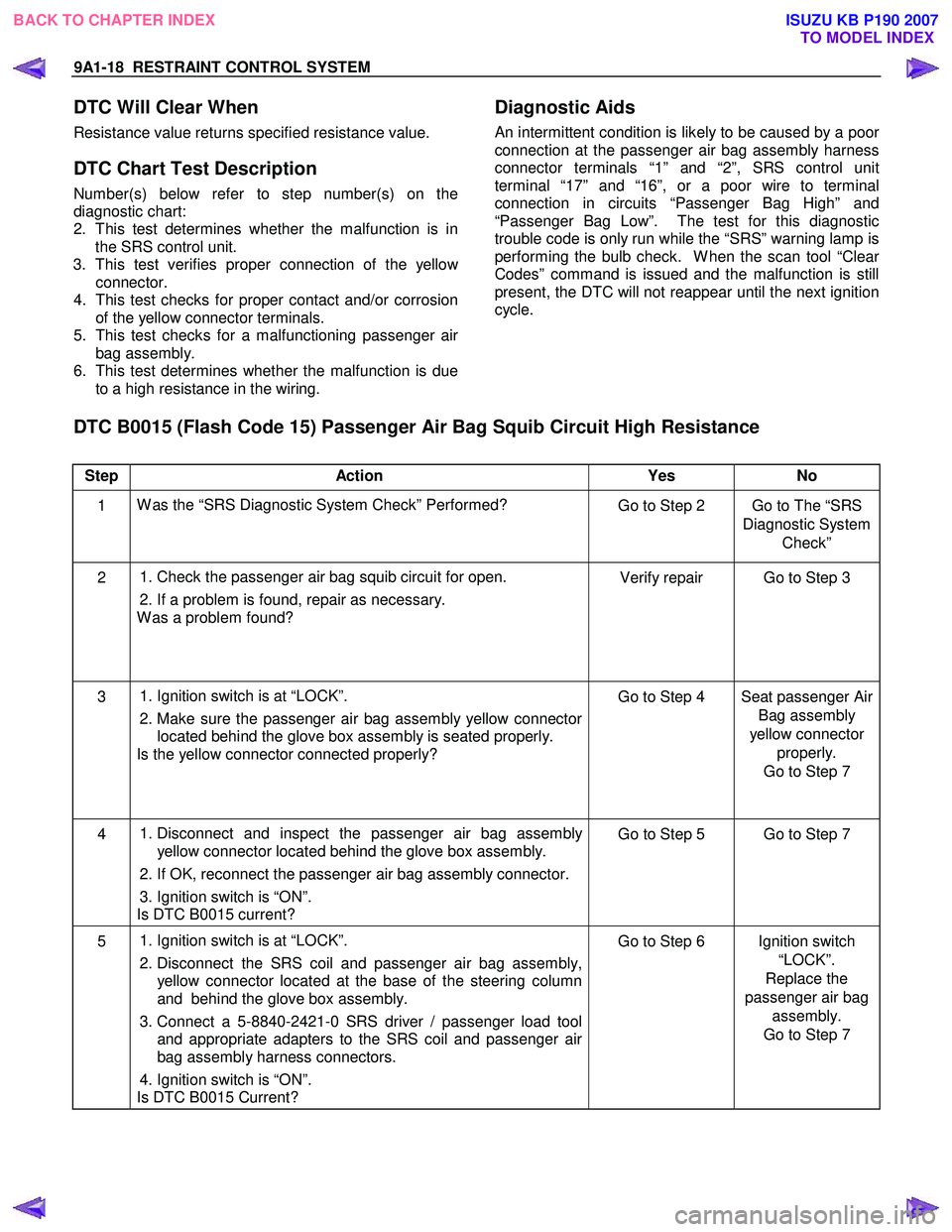
9A1-18 RESTRAINT CONTROL SYSTEM
DTC Will Clear When
Resistance value returns specified resistance value.
DTC Chart Test Description
Number(s) below refer to step number(s) on the
diagnostic chart:
2. This test determines whether the malfunction is in
the SRS control unit.
3. This test verifies proper connection of the yello
w
connector.
4. This test checks for proper contact and/or corrosion
of the yellow connector terminals.
5. This test checks for a malfunctioning passenger ai
r
bag assembly.
6. This test determines whether the malfunction is due
to a high resistance in the wiring.
Diagnostic Aids
An intermittent condition is likely to be caused by a poor
connection at the passenger air bag assembly harness
connector terminals “1” and “2”, SRS control unit
terminal “17” and “16”, or a poor wire to terminal
connection in circuits “Passenger Bag High” and
“Passenger Bag Low”. The test for this diagnostic
trouble code is only run while the “SRS” warning lamp is
performing the bulb check. W hen the scan tool “Clea
r
Codes” command is issued and the malfunction is still
present, the DTC will not reappear until the next ignition
cycle.
DTC B0015 (Flash Code 15) Passenger Air Bag Squib Circuit High Resistance
Step Action Yes No
1 W as the “SRS Diagnostic System Check” Performed?
Go to Step 2 Go to The “SRS
Diagnostic System Check”
2
1. Check the passenger air bag squib circuit for open.
2. If a problem is found, repair as necessary.
W as a problem found? Verify repair Go to Step 3
3
1. Ignition switch is at “LOCK”.
2. Make sure the passenger air bag assembly yellow connector
located behind the glove box assembly is seated properly.
Is the yellow connector connected properly? Go to Step 4 Seat passenger Air
Bag assembly
yellow connector properly.
Go to Step 7
4
1. Disconnect and inspect the passenger air bag assembly
yellow connector located behind the glove box assembly.
2. If OK, reconnect the passenger air bag assembly connector.
3. Ignition switch is “ON”.
Is DTC B0015 current? Go to Step 5 Go to Step 7
5
1. Ignition switch is at “LOCK”.
2. Disconnect the SRS coil and passenger air bag assembly,
yellow connector located at the base of the steering column
and behind the glove box assembly.
3. Connect a 5-8840-2421-0 SRS driver / passenger load tool
and appropriate adapters to the SRS coil and passenger air
bag assembly harness connectors.
4. Ignition switch is “ON”.
Is DTC B0015 Current? Go to Step 6 Ignition switch
“LOCK”.
Replace the
passenger air bag assembly.
Go to Step 7
BACK TO CHAPTER INDEX TO MODEL INDEX
ISUZU KB P190 2007
Page 5701 of 6020
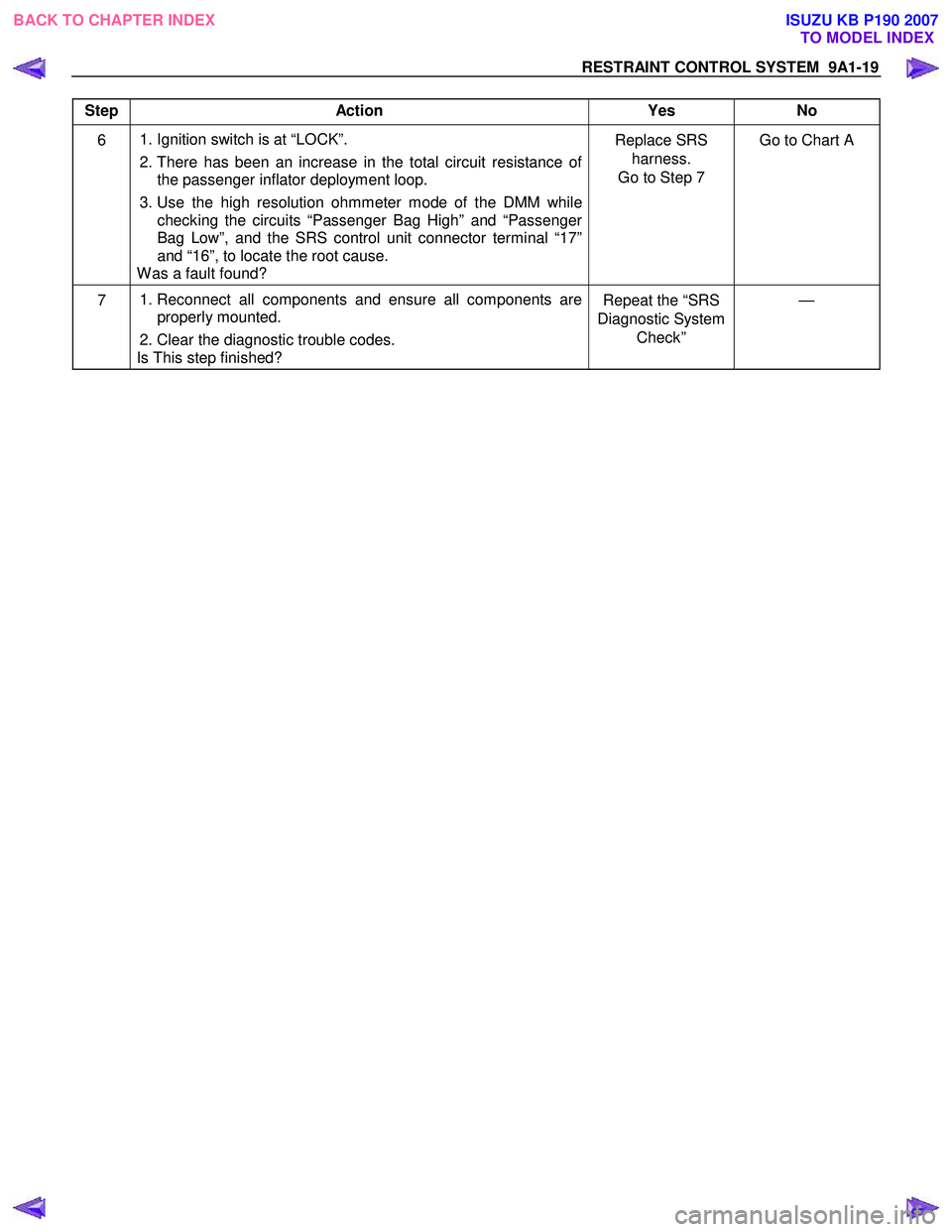
RESTRAINT CONTROL SYSTEM 9A1-19
Step Action Yes No
6
1. Ignition switch is at “LOCK”.
2. There has been an increase in the total circuit resistance of
the passenger inflator deployment loop.
3. Use the high resolution ohmmeter mode of the DMM while
checking the circuits “Passenger Bag High” and “Passenger
Bag Low”, and the SRS control unit connector terminal “17”
and “16”, to locate the root cause.
W as a fault found? Replace SRS
harness.
Go to Step 7 Go to Chart A
7
1. Reconnect all components and ensure all components are
properly mounted.
2. Clear the diagnostic trouble codes.
Is This step finished? Repeat the “SRS
Diagnostic System Check” —
BACK TO CHAPTER INDEX
TO MODEL INDEX
ISUZU KB P190 2007
Page 5703 of 6020
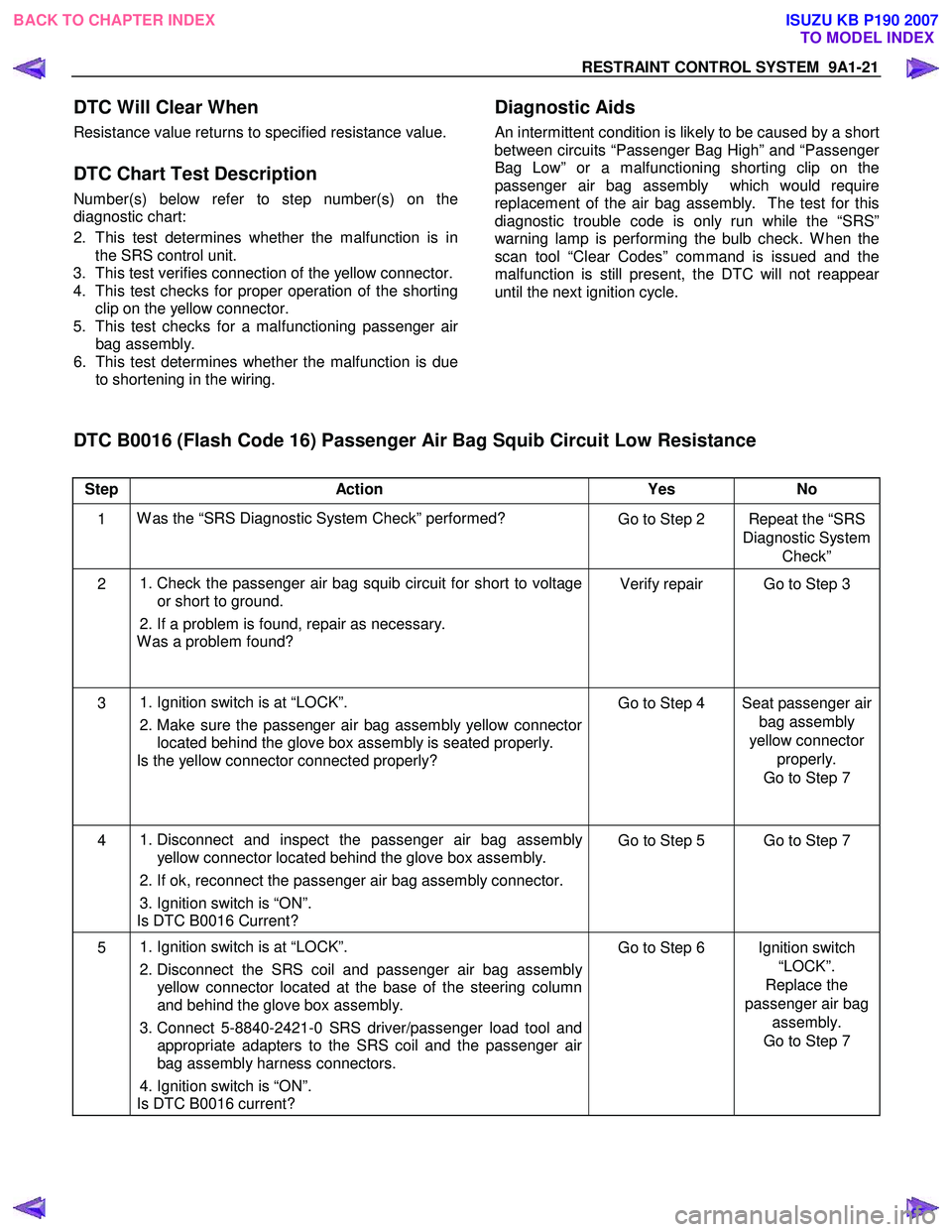
RESTRAINT CONTROL SYSTEM 9A1-21
DTC Will Clear When
Resistance value returns to specified resistance value.
DTC Chart Test Description
Number(s) below refer to step number(s) on the
diagnostic chart:
2. This test determines whether the malfunction is in
the SRS control unit.
3. This test verifies connection of the yellow connector.
4. This test checks for proper operation of the shorting
clip on the yellow connector.
5. This test checks for a malfunctioning passenger ai
r
bag assembly.
6. This test determines whether the malfunction is due
to shortening in the wiring.
Diagnostic Aids
An intermittent condition is likely to be caused by a short
between circuits “Passenger Bag High” and “Passenge
r
Bag Low” or a malfunctioning shorting clip on the
passenger air bag assembly which would require
replacement of the air bag assembly. The test for this
diagnostic trouble code is only run while the “SRS”
warning lamp is performing the bulb check. W hen the
scan tool “Clear Codes” command is issued and the
malfunction is still present, the DTC will not reappea
r
until the next ignition cycle.
DTC B0016 (Flash Code 16) Passenger Air Bag Squib Circuit Low Resistance
Step Action Yes No
1 W as the “SRS Diagnostic System Check” performed?
Go to Step 2 Repeat the “SRS
Diagnostic System Check”
2
1. Check the passenger air bag squib circuit for short to voltage
or short to ground.
2. If a problem is found, repair as necessary.
W as a problem found? Verify repair Go to Step 3
3
1. Ignition switch is at “LOCK”.
2. Make sure the passenger air bag assembly yellow connector
located behind the glove box assembly is seated properly.
Is the yellow connector connected properly? Go to Step 4 Seat passenger air
bag assembly
yellow connector properly.
Go to Step 7
4
1. Disconnect and inspect the passenger air bag assembly
yellow connector located behind the glove box assembly.
2. If ok, reconnect the passenger air bag assembly connector.
3. Ignition switch is “ON”.
Is DTC B0016 Current? Go to Step 5 Go to Step 7
5
1. Ignition switch is at “LOCK”.
2. Disconnect the SRS coil and passenger air bag assembly
yellow connector located at the base of the steering column
and behind the glove box assembly.
3. Connect 5-8840-2421-0 SRS driver/passenger load tool and
appropriate adapters to the SRS coil and the passenger air
bag assembly harness connectors.
4. Ignition switch is “ON”.
Is DTC B0016 current? Go to Step 6 Ignition switch
“LOCK”.
Replace the
passenger air bag assembly.
Go to Step 7
BACK TO CHAPTER INDEX TO MODEL INDEX
ISUZU KB P190 2007
Page 5704 of 6020
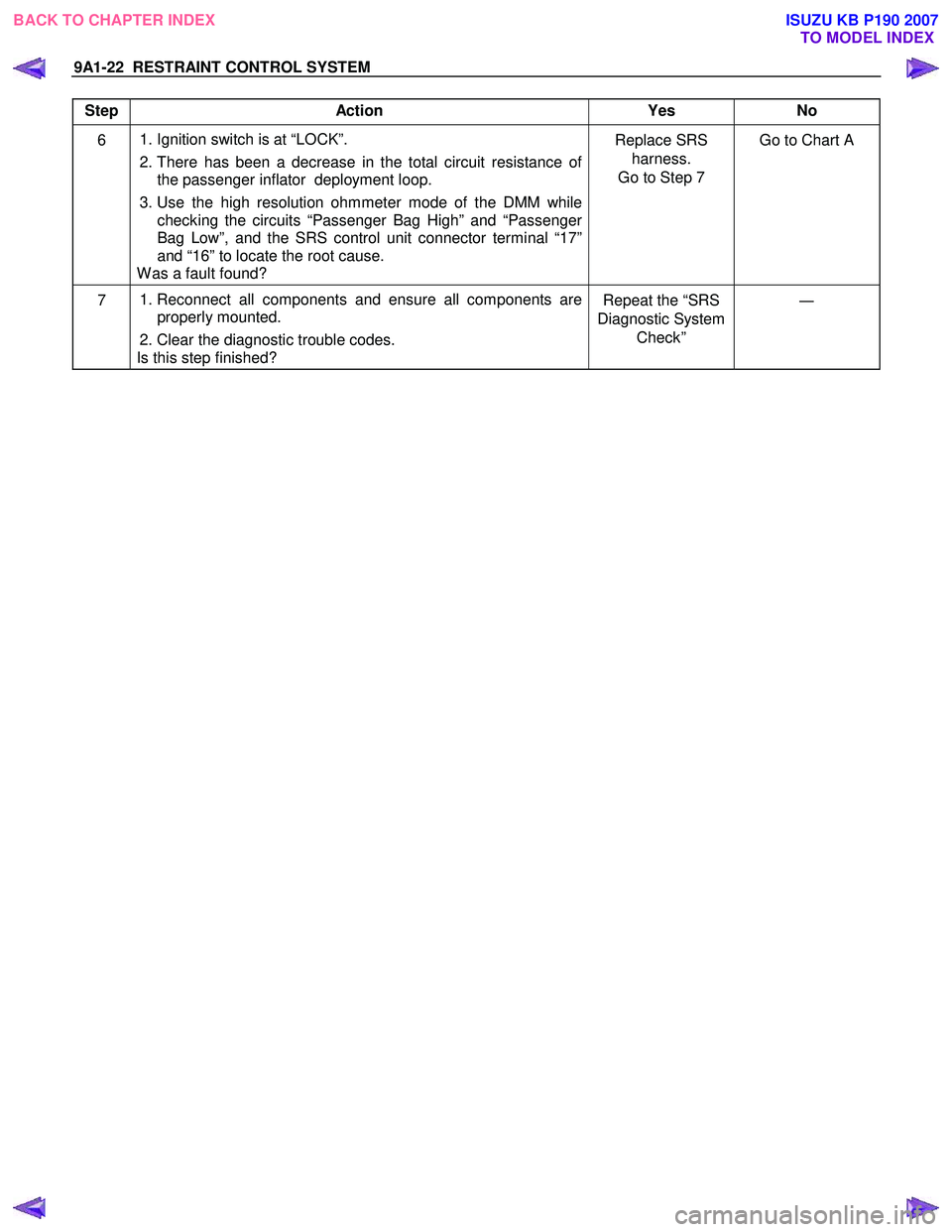
9A1-22 RESTRAINT CONTROL SYSTEM
Step Action Yes No
6
1. Ignition switch is at “LOCK”.
2. There has been a decrease in the total circuit resistance of
the passenger inflator deployment loop.
3. Use the high resolution ohmmeter mode of the DMM while checking the circuits “Passenger Bag High” and “Passenger
Bag Low”, and the SRS control unit connector terminal “17”
and “16” to locate the root cause.
W as a fault found? Replace SRS
harness.
Go to Step 7 Go to Chart A
7
1. Reconnect all components and ensure all components are
properly mounted.
2. Clear the diagnostic trouble codes.
Is this step finished? Repeat the “SRS
Diagnostic System Check” ―
BACK TO CHAPTER INDEX
TO MODEL INDEX
ISUZU KB P190 2007